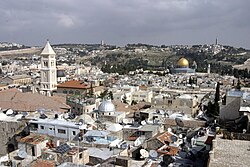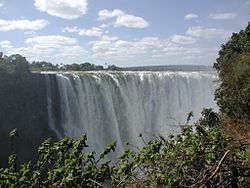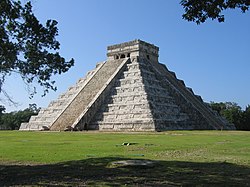Wonders of the World
The Seven Wonders of the World (or the Seven Wonders of the Ancient World) is a widely-known list of seven great buildings or structures from the classical time period.
Seven Wonders of the Ancient World
This is a list put together in the 2nd century BC by Antipater of Sidon and Philon of Byzantium. This explains why it only lists monuments of the Mediterranean world. There are other slightly different versions: this is the most usual one.
- Great Pyramid of Giza (Egyptian). The oldest of the wonders, and the only one still standing.
- Hanging Gardens of Babylon (Babylonian). Built by Queen Semmu-ramat (= Semi-ramis) or King Nebuchadnazzer II. The exact location of this monument is not known. It was in Mesopotamia.
- Statue of Zeus at Olympia (Greek). A gigantic statue made of marble and ivory, with applied gold leaf.
- Temple of Artemis (Greek). In Ephesus, Asia Minor (modern Turkey), on the Aegean Sea. It was burnt down by Herostratus on 21 July 350 BC. When questioned, he is said to have replied: "To make my name immortal". First known crime committed for fame.
- Mausoleum of Maussollos (Persian). Tomb of the Anatolian king of that name, built by his widow Artemisia, at Halicarnassus (present Bodrum, Turkey).
- Colossus of Rhodes (Greek). Built to commemorate the raising of the siege of Rhodes 304–5 BC. At 30 metres, the tallest statue in the ancient world.
- Lighthouse of Alexandria (Egyptian/Greek). Called the Pharos, this was built for Ptolemy II, about 280 BC. To this day, Pharos is the name for lighthouse in several European languages.
Out of those structures only the Great Pyramid still exists in the 21st century. Most of the wonders were built by the Greeks. Earlier versions listed the Walls of Babylon and the Palace of Cyrus the Great.
Seven wonders of the modern world
This version was decided by the American Society of Civil Engineers.
Seven natural wonders of the world
There is no single list of seven natural wonders of the world. One of the many lists was compiled by CNN:
- Grand Canyon
- Great Barrier Reef
- Harbour of Rio de Janeiro
- Mount Everest
- Aurora
- Parícutin volcano
- Victoria Falls
New7Wonders of the World was an idea to choose new wonders of the world from a selection of 200 existing monuments.[1] The mission began in 2001 and ended in 2007 with the announcement of the winners. The popularity poll was led by Canadian-Swiss Bernard Weber and organized by the New7Wonders Foundation in Zürich, Switzerland. Voting took place through the Internet or by telephone.
The program caused different reactions from countries and organisations. Some countries praised their finalist and tried to get more people to vote for it. Others criticized the contest or did not think it was very important.[2][3]
Among the strongest criticism was from UNESCO,[4] who said in a press release in 2007:[5]
There is no comparison between Mr. Weber's mediatised campaign and the scientific and educational work resulting from the inscription of sites on UNESCO's World Heritage List. The list of the 8 New Wonders of the World will be the result of a private undertaking, reflecting only the opinions of those with access to the Internet and not the entire world. This initiative cannot, in any significant and sustainable manner, contribute to the preservation of sites elected by this public.
—
Winners:
- Great Pyramid of Giza (awarded honorary status)
- Great Wall of China
- Petra (Jordan)
- Colosseum (Rome)
- Chichen Itza (Yucatán)
- Machu Picchu (Peru)
- Taj Mahal (India)
- Christ the Redeemer (statue in Rio de Janeiro)
Other modern lists
From a variety of modern lists of wonders made by man, some items occur several times:
- The Taj Mahal, India
- The Colosseum in Rome
- The Great Wall of China
- Stonehenge, England. The only prehistoric site on any list.
- Machu Picchu, Peru
- The Hagia Sophia. One of many places of worship which might be candidates.
- Angkor Wat, Cambodia
Wonders Of The World Media
The Great Pyramid of Giza, the only wonder of the ancient world still in existence
CN Tower in Toronto, Canada
Calle Crisologo, Vigan City
References
- ↑ "How the New7Wonders movement all began - World of New7Wonders". World of New7Wonders. Archived from the original on 17 February 2014. Retrieved 23 October 2016.
- ↑ Dwoskin, Elizabeth (2007-07-09). "Vote for Christ". Newsweek. .
- ↑ The Seven Wonders of the World, 2.0, Los Angeles Times, 2007-07-07 Retrieved 25 October 2016
- ↑ "New7Wonders and UNESCO: Separate organizations, common goals". World of New7Wonders. 8 June 2007. Retrieved 25 October 2016.
- ↑ "UNESCO confirms that it is not involved in the "New7Wonders of the World" campaign". UNESCO. July 9, 2007. Retrieved 25 October 2016.
More reading
- Iggulden, Hal; Iggulden, Conn (2007). "The Seven Wonders of the Ancient World" [&] "Seven Modern Wonders of the World". The Dangerous Book for Boys. New York: HarperCollins. pp. 4–8 & 256–261. ISBN 978-0061243585.








